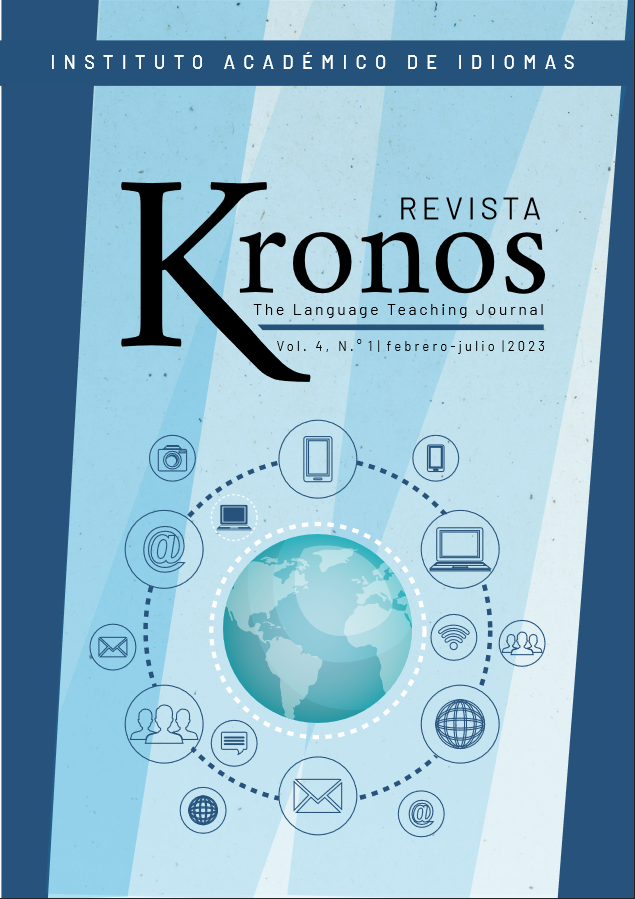Use of padlet for the implementation of the writing process
DOI:
https://doi.org/10.29166/kronos.v4i1.4241Keywords:
collaborative writing, writing skills, writing process, PadletAbstract
This research project intended to enhance the writing abilities of English language learners by the implementation of the writing process through the collaborative use of the technological tool Padlet. The intervention included five weeks of instruction on the various writing phases. The study's participants included forty high school students. They
struggled to write coherent, comprehensive paragraphs and had a competency level between A1 and A2. The researcher used a pretest-posttest design to evaluate the progress in the students' writing. The viewpoints of learners toward the innovation were gathered by pre- and post-survey applications. In order to determine how the students interacted
and participated in the group projects' writing assignments, observation checklists were completed. The post-test scores were higher than the pre-test scores. revealing a Cohen’s d = 0.33. The findings revealed that implementing the writing the process helped learners improve the quality of their writing pieces whereas the collaborative use of Padlet contributed to increase their levels of confidence and motivation in writing activities. The study has significance for language teachers and learners because it might raise helpful insights concerning the importance of collaborating with students to follow a writing process and enhance the quality of their writing.
Downloads
References
Belhabib, I. (2014). Difficulties Encountered by Students in Learning the Productive Skills in the EFL Classroom and the Relationship between Speaking and Writing: Case of First Year LMD Students at Abou Bekr-Belkaid (master’s thesis). University of Tlemcen, Algeria. Retrieved from http://dspace.univ-tlemcen.dz/handle/112/7856
Bialo, E. R. & Sivin-Kachala, J. (1996). The Effectiveness of Technology in Schools: A summary of Recent Research. SLMQ. 25(1) Retrieved from: http://www.ala.org/aasl/sites/ala.org.aasl/files/content/aaslpubsandjournals/slr/edchoice/SLMQ _EffectivenessofTechnologyinSchools_InfoPower.pdf
Chen, Y. (2018). Perceptions of EFL College Students toward Collaborative Learning. English Language Teaching, 11(2), 1-4. Retrieved from https://files.eric.ed.gov/fulltext/EJ1164588.pdf
Davies, J. (2010). A Space for play: crossing boundaries and learning online. In V.
Carrington & M. Robinson (Eds.), Digital literacies: social learning and classroom practices, 27-41. London: Sage.
De Berg, A. (2016). Students as producers and collaborators: exploring the use of
padlets and videos in MFL teaching. In C. Goria, O. Speicher, & S. Stollhans (Eds), Innovative language teaching and learning at university: enhancing participation and collaboration. 1, 59-64. Research-publishing.net. doi: 10.14705/rpnet.2016.000405
Dooey, P. (2006). Identifying the listening and speaking needs of international students. Experience of Learning. Proceedings of the 15th Annual Teaching Learning Forum, 1-2 February 2006. Perth: The University of Western Australia. http://lsn.curtin.edu.au/tlf/tlf2006/refereed/dooey.html
Elbow, P. & Belanoff, P. (1995). A community of writers: a workshop course in writing. New York: McGraw-Hill.
Faraj, A. K. A. (2015). Scaffolding EFL Students’ Writing through the Writing Process Approach. Journal of Education and Practice, 6(13), 131-141. Retrieved from https://files.eric.ed.gov/fulltext/EJ1080494.pdf
Flowers, S. (2015). Friendship and Reciprocity as Motivators in CSCL. JALT CALL
Journal, 11(3), 191-212. Retrieved from https://files.eric.ed.gov/fulltext/EJ1107998.pdf
Fuchs, B. (2014). The Writing is on the Wall: Using Padlet for Whole-Class
Engagement. Library Faculty and Staff Publications. 240. Retrieved from https://uknowledge.uky.edu/libraries_facpub/240
Godwin-Jones, R. (2018). Second language writing online: An update. Language
Learning & Technology, 22(1), 1-15. Retrieved from https://dx.doi.org/10125/44574
Harmer, J. (1998). How to Teach English: An introduction to the practice of English
language teaching. Edinburgh Gate, Harlow, England: Addison Wesley Longman. Retrieved from http://www.cje.ids.czest.pl/biblioteka/how%20to%20teach.pdf
Javadi-Safa, A. (2018). A Brief Overview of Key Issues in Second Language Writing
Teaching and Research. International Journal of Education and literacy Studies, 6(2). Retrieved from https://files.eric.ed.gov/fulltext/EJ1182214.pdf
Laksmi, E. D. (2006). "Scaffolding" Students' Writing in EFL Class: Implementing
Process Approach. TEFLIN Journal: A publication on the teaching and learning of English, 17(2). Retrieved from http://citeseerx.ist.psu.edu/viewdoc/download?doi=10.1.1.668.1486&rep=rep1&type=pdf
Mallon, M. & Bernsten, S. (2015). Collaborative learning technologies. Tips and trends. Retrieved from http://www.ala.org/acrl/sites/ala.org.acrl/files/content/aboutacrl/directoryofleadership/sections/is/iswebsite/projpubs/tipsandtrends/winter2015.pdf
Manitoba Education and Training (1998). Kindergarten to Grade 4 English Language
Arts: A foundation for implementation. Winipeg, MB: Manitoba Education and Training. Retrieved from https://www.edu.gov.mb.ca/k12/tech/imym/4/ole/6.pdf)
Manowong, S. (2017). Incorporating Online Tools to Promote English Reading for EFL Learners: an Action Research Study. Pasaa Paritat Journal, 32, 98-194. Retrieved fromhttp://www.culi.chula.ac.th/publicationsonline/files/article2/Uz8VwjDfrZMon32902.pdf
Matsuya, Y. (2003). English Teaching in Japan. California Linguistic Notes, 28(1).
Retrieved from http://english.fullerton.edu/publications/clnArchives/pdf/matsuya englishedjapan.pdf
McWhaw, K., Schnackenberg, H., Sclater, J., & Abrami, P. (2003). From co-operation to Collaboration: Helping students become collaborative learners. In R. M. Gillies & A. F. Ashman (Eds.), Cooperative learning: the social and intellectual outcomes of learning in groups. New York: Routledge Falmer
Ministerio de Educación. (2012). Standards of Quality Education. Retrieved from
https://educacion.gob.ec/wp_content/uploads/downloads/2012/09/estandares_2012_ingles_opt.pdf
Ministerio de Educación. (2016). English as a Foreign Language. Retrieved from
https://educacion.gob.ec/wp-content/uploads/downloads/2016/08/EFL-for-Subnivel-BGU-final-ok.pdf
MunirahHaris, Yunus, & Jamaludin. (2017). The Effectiveness of using Padlet in
ESL classroom. International Journal of Advanced Research, 5(2), 783-788. doi: 10.21474/IJAR01/3214
Rivera, A. (2018). Motivating English Language Use by Using the Benefits of
Technology. GIST Education and Learning Research Journal, 1(16), 117-140. doi: https://doi.org/10.26817/16925777.428
Yau, H. (2007). Scaffolding the Writing Process. Education and Human Development
Master’s These. 298. Retrieved from http://digitalcommons.brokport .edu/ehd_these/298
Published
How to Cite
Issue
Section
License
Copyright (c) 2023 Helen Moreira Olives, Carlos Álvarez Llerena

This work is licensed under a Creative Commons Attribution-NonCommercial-ShareAlike 4.0 International License.












